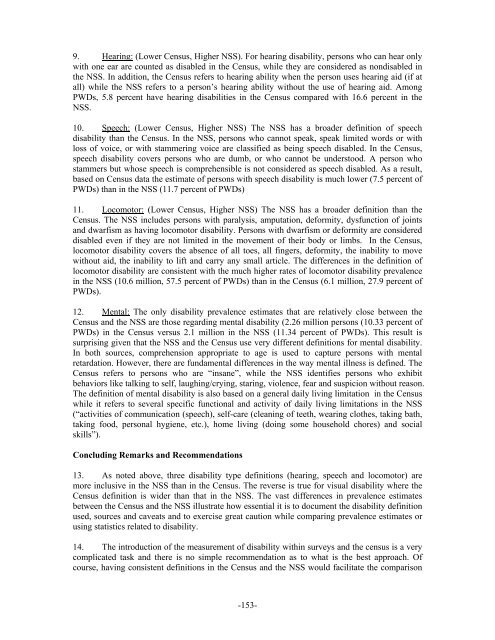People with Disabilities in India: From Commitment to Outcomes
People with Disabilities in India: From Commitment to Outcomes
People with Disabilities in India: From Commitment to Outcomes
Create successful ePaper yourself
Turn your PDF publications into a flip-book with our unique Google optimized e-Paper software.
9. Hear<strong>in</strong>g: (Lower Census, Higher NSS). For hear<strong>in</strong>g disability, persons who can hear only<br />
<strong>with</strong> one ear are counted as disabled <strong>in</strong> the Census, while they are considered as nondisabled <strong>in</strong><br />
the NSS. In addition, the Census refers <strong>to</strong> hear<strong>in</strong>g ability when the person uses hear<strong>in</strong>g aid (if at<br />
all) while the NSS refers <strong>to</strong> a person’s hear<strong>in</strong>g ability <strong>with</strong>out the use of hear<strong>in</strong>g aid. Among<br />
PWDs, 5.8 percent have hear<strong>in</strong>g disabilities <strong>in</strong> the Census compared <strong>with</strong> 16.6 percent <strong>in</strong> the<br />
NSS.<br />
10. Speech: (Lower Census, Higher NSS) The NSS has a broader def<strong>in</strong>ition of speech<br />
disability than the Census. In the NSS, persons who cannot speak, speak limited words or <strong>with</strong><br />
loss of voice, or <strong>with</strong> stammer<strong>in</strong>g voice are classified as be<strong>in</strong>g speech disabled. In the Census,<br />
speech disability covers persons who are dumb, or who cannot be unders<strong>to</strong>od. A person who<br />
stammers but whose speech is comprehensible is not considered as speech disabled. As a result,<br />
based on Census data the estimate of persons <strong>with</strong> speech disability is much lower (7.5 percent of<br />
PWDs) than <strong>in</strong> the NSS (11.7 percent of PWDs)<br />
11. Locomo<strong>to</strong>r: (Lower Census, Higher NSS) The NSS has a broader def<strong>in</strong>ition than the<br />
Census. The NSS <strong>in</strong>cludes persons <strong>with</strong> paralysis, amputation, deformity, dysfunction of jo<strong>in</strong>ts<br />
and dwarfism as hav<strong>in</strong>g locomo<strong>to</strong>r disability. Persons <strong>with</strong> dwarfism or deformity are considered<br />
disabled even if they are not limited <strong>in</strong> the movement of their body or limbs. In the Census,<br />
locomo<strong>to</strong>r disability covers the absence of all <strong>to</strong>es, all f<strong>in</strong>gers, deformity, the <strong>in</strong>ability <strong>to</strong> move<br />
<strong>with</strong>out aid, the <strong>in</strong>ability <strong>to</strong> lift and carry any small article. The differences <strong>in</strong> the def<strong>in</strong>ition of<br />
locomo<strong>to</strong>r disability are consistent <strong>with</strong> the much higher rates of locomo<strong>to</strong>r disability prevalence<br />
<strong>in</strong> the NSS (10.6 million, 57.5 percent of PWDs) than <strong>in</strong> the Census (6.1 million, 27.9 percent of<br />
PWDs).<br />
12. Mental: The only disability prevalence estimates that are relatively close between the<br />
Census and the NSS are those regard<strong>in</strong>g mental disability (2.26 million persons (10.33 percent of<br />
PWDs) <strong>in</strong> the Census versus 2.1 million <strong>in</strong> the NSS (11.34 percent of PWDs). This result is<br />
surpris<strong>in</strong>g given that the NSS and the Census use very different def<strong>in</strong>itions for mental disability.<br />
In both sources, comprehension appropriate <strong>to</strong> age is used <strong>to</strong> capture persons <strong>with</strong> mental<br />
retardation. However, there are fundamental differences <strong>in</strong> the way mental illness is def<strong>in</strong>ed. The<br />
Census refers <strong>to</strong> persons who are “<strong>in</strong>sane”, while the NSS identifies persons who exhibit<br />
behaviors like talk<strong>in</strong>g <strong>to</strong> self, laugh<strong>in</strong>g/cry<strong>in</strong>g, star<strong>in</strong>g, violence, fear and suspicion <strong>with</strong>out reason.<br />
The def<strong>in</strong>ition of mental disability is also based on a general daily liv<strong>in</strong>g limitation <strong>in</strong> the Census<br />
while it refers <strong>to</strong> several specific functional and activity of daily liv<strong>in</strong>g limitations <strong>in</strong> the NSS<br />
(“activities of communication (speech), self-care (clean<strong>in</strong>g of teeth, wear<strong>in</strong>g clothes, tak<strong>in</strong>g bath,<br />
tak<strong>in</strong>g food, personal hygiene, etc.), home liv<strong>in</strong>g (do<strong>in</strong>g some household chores) and social<br />
skills”).<br />
Conclud<strong>in</strong>g Remarks and Recommendations<br />
13. As noted above, three disability type def<strong>in</strong>itions (hear<strong>in</strong>g, speech and locomo<strong>to</strong>r) are<br />
more <strong>in</strong>clusive <strong>in</strong> the NSS than <strong>in</strong> the Census. The reverse is true for visual disability where the<br />
Census def<strong>in</strong>ition is wider than that <strong>in</strong> the NSS. The vast differences <strong>in</strong> prevalence estimates<br />
between the Census and the NSS illustrate how essential it is <strong>to</strong> document the disability def<strong>in</strong>ition<br />
used, sources and caveats and <strong>to</strong> exercise great caution while compar<strong>in</strong>g prevalence estimates or<br />
us<strong>in</strong>g statistics related <strong>to</strong> disability.<br />
14. The <strong>in</strong>troduction of the measurement of disability <strong>with</strong><strong>in</strong> surveys and the census is a very<br />
complicated task and there is no simple recommendation as <strong>to</strong> what is the best approach. Of<br />
course, hav<strong>in</strong>g consistent def<strong>in</strong>itions <strong>in</strong> the Census and the NSS would facilitate the comparison<br />
-153-










